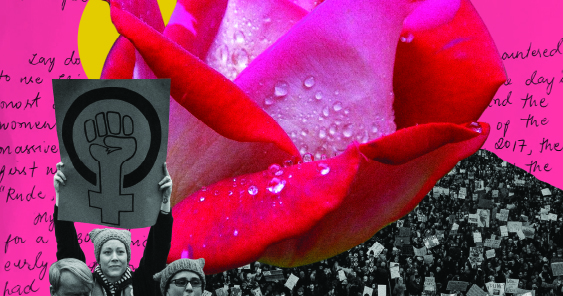Words by Ninotchka Rosca
Photo courtesy of The New York Times
Lay down a call to action on familiar issues on those encountered, to use Elizabeth Barrett Browning’s words, at the “level of the day’s most quiet need.” But look at them through women’s eyes, and the women will be at the barricades. This was the first lesson of the massive Women’s March on Washington DC, on January 21st, 2017, the first unfurling of the resistance banner against the rising of the “Rude, Crude, and Deadly” that is fascism.
My two companions and I thought reaching Port Authority by 3 am for a 4:30 bus ride from New York to Washington DC would be early enough for a leisurely saunter to the gate. Wrong. A queue had already formed in front of the gate and it stretched longer and longer by the minute, such that 30 minutes later, it had become an ouroboros, start saying hello to its end.
Ninety per cent were females, mostly Caucasian, and a number wore the knitted pink pussy bonnets that would drive certain elements into a frenzy, denouncing the march as vagina-centered, never mind that the caps were a direct response to President Donald Trump’s “grab her by the pussy” advice to the brotherhood of the without-couth.
The prelude to the most massive protest mobilization ever—a low estimate of 3.3 million in 550 cities, towns and villages, with 600,000 marching in Washington DC alone and not counting marches in 100 countries worldwide—was tense and intense. As with most things initiated by women, there was second-guessing galore and many an excuse for recalcitrance.
Why was the leadership white? Was this a Democratic Party thing? Is this a defense of neo-liberalism? Who was funding this? And is this march only for women? It was an astonishing reprise of the presidential election campaign, when everything even the kitchen sink was used to justify and in effect, to effect the disastrous victory of Donald Trump at the polls. It seemed no one had learned anything from the experience.
But as demonstration day inched closer, the leadership of the Women’s March came to include different races and ethnicities. The program on stage came to include a diversity of presenters and performers. And its Statement of Purpose came to be a study in the quiet articulation of what needed to be done, minus the often hortatory high-decibel calls to a rebellion.
“We stand together in solidarity with our partners and children for the protection of our rights, our safety, our health, and our families – recognizing that our vibrant and diverse communities are the strength of our country.” Simple and immediately comprehensible; no obscuring jargon.
By bus from New York City to Washington DC took four hours, and it wouldn’t be an overstatement to say that the mostly female passengers maintained a high level of enthusiasm throughout the ride. Clear eyed, beaming and with palpable excitement as they prepared for the march, some trading placards, hats, pins, even armbands. There was a solid feel of commitment and determination, not to change anything instantly nor to create monuments of heroic endeavors, but just to be present, to make what one political writer called “the subjugated majority” visible in all its reality and power. When we reached the Washington DC bus terminal, it was packed: women, women, women everywhere. Outside, through the streets and parks, streams of women headed for the rally area, in groups or solo, yet in sync. A woman walked—or rather limped—ahead of us; she was on crutches but had her hand-made placard strapped on her back.
We lost half of our organization’s contingent, since they had come by a different bus. Innumerable cell phone calls later, we learned that they had made their way toward the stage and then found themselves wedged within a solid mass of people. They would try to move. Two hours later, they still couldn’t move. Half a million people was a lot of people and though ripples ran through the crowd as the women tried to get to better vantage points, it remained solid. I thought of penguins huddled in the Antarctic storm, wriggling their way in small movements toward the warmth at the center, yet never disturbing the density of its mass. Yes, it was cold and in due time, we lost the cell phone signal, even cyber space was overwhelmed.
The variety of causes represented at the Women’s March was dizzying. We encountered the Water Protectors of the Native Americans, domestic workers, migrants and immigrants, high school students, labor union women and of course, a sea of Caucasian women. We found ourselves in one such group; they were marching stoically and mutely, just putting one foot in front of the other—and being what we were, we began a loud rolling chant, followed by songs, then chants again. After the initial diffidence, those around us picked up our noise, roiled it to the sky and then backward and forward, until our section of the march was rocking to chants and impromptu singing. What looked like a thousand cell phone cameras swiveled in our direction—an oasis of brown in a white sand desert. We didn’t mind, so long as they followed our lead. This too was a lesson.
After the Storm
What did the March accomplish, aside from women being suddenly and visibly intruding into the global political discourse? Seeing the huge mass of women, I learned what was meant by a political analyst who called women “a political class” and a “subjugated majority.” I saw clearly why Friedrich Engels wrote about “the historic defeat of womankind”—and not the defeat of this or that kind or class of women but of all women. While we may come from different classes, different cultures, different histories, patriarchy lumps us together into one category—the gender which must remain subdued, whose labor can be stolen to maintain hierarchical social formations, whose bodies must exist for the purpose of fulfilling others.
Donald Trump’s “grab her by the pussy” confirmed a historic reality: that women’s oppression was directly linked to the woman’s dispossession of her body, her sexuality, her reproduction. Class societies have managed to exist and to reinvent itself on that singular theft.
In the flurry and fury of these days leading to International Women’s Day, the question has been flung at me, time and again: What is feminism? Isn’t feminism about choice? Yes and no. Choices should be available, of course. But more than that, the feminism that seeks to change the world of humans by ending political, economic, social and individual hierarchies of exploitation is about creating the right and the freedom, and providing the resources for women to make a choice.









